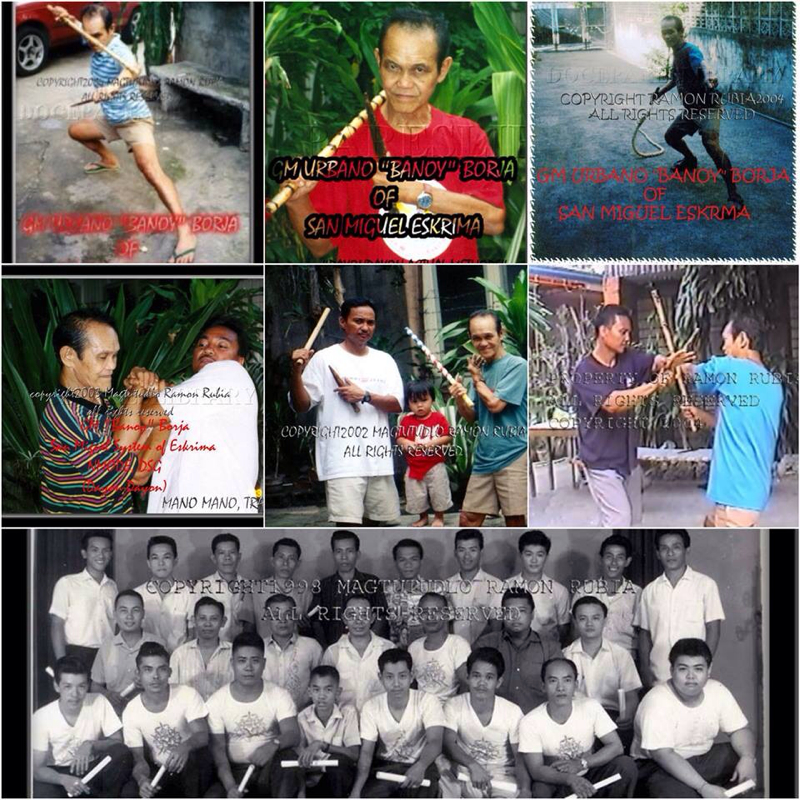|
This blog posting is months overdue. We've been busy training. We also lost a couple of living treasures in the world of eskrima, including Nong Tony Diego of Ilustrisimo Repeticion Orihinal, and more recently Nong Banoy Borja, our instructor's main instructor in the San Miguel System of Eskrima, Nong Momoy's Orihinal Disciples -- Depensa Seguidas Group (SMSOE, NMODE--DSG). This three-part blog was actually written prior to the unexpected passing of Nong Banoy. However, this piece will stay intact. We will proudly continue to honor Nong Banoy's training methodology and his teachings, as passed down from Grandmaster Momoy Cañete, and taught to us by Magtutudlo Ramon Rubia.
~LTT Transcending Conventional Eskrima: History Part 1 of 3 There is something missing in the legendary stories being marketed to the followers of the modern-day ‘conglomeration of multiple styles’ in eskrima. It’s curious that the stories of old are very limited in detail, right down to a very superficial level. Some even dare to modify their own history in the art in order to boost their name and recognition to a whole new generation of unsuspecting eskrima newbies. But people are keeping track. Perhaps the new people aren’t asking the right questions. The generic blueprint of the story being passed around the globe is the story that the Doce Pares Club was founded in 1932 in Cebu. Some Doce Pares-affiliated groups promote bits and pieces of the Club name inspiration involving the 12 guards of Charlemagne of France. They mention the involvement of the Saavedras and a couple of the older Cañete brothers, among others, and the eventual Club division which led to the rivalry with the Balintawak group during what we now refer to as the Golden Age of eskrima. There are plenty of black-and-white Club photos which can be freely found across the internet, with some recognizable faces and even fewer recognizable names of Doce Pares Club eskrima. The problem is that nobody is differentiating the methods of these oft-mentioned eskrimadors. Back in the day, Cebu was supposed to be the hub of eskrima. Eskrimadors travelled from all across the Philippines to duel with or train at the Club. Does anybody even care who these people are, or how they fought? The point that I’m trying to get at is that there doesn’t seem to be enough detailed history being told behind the story by these modern masters and grandmasters of eskrima. Grandmaster Urbano ‘Banoy’ Borja, or Nong Banoy, as Magtutudlo Ramon typically refers to him, is not widely known to the younger generations of people or those involved in learning Doce Pares eskrima outside of Cebu. Nong Banoy trained with GM Momoy and the Doce Pares Club in the 1950’s and 1960’s. He represented the Club in challenge matches with other eskrimadors. At the Doce Pares Club Branch #7 of Latophan, Toledo, Cebu, he was the Chief Instructor of his own group. The older Doce Pares Club members who were physically present during this time would know of this fact. When you mention his name to the older eskrimadors, they will most likely say that his combat judo was ‘very good.’ To be the Chief Instructor of any branch at the Club, for that matter, and carry a reputation especially for combat judo, was a big deal. It means that Nong Banoy actually used eskrima that worked effectively in combative situations, and his methods were teachable. It also helped that he was formally educated, held a good job with an international company as a driver, and speaks good English. These qualities helped Nong Banoy to articulate his deep knowledge of eskrima to the select few who have desired to go deeper into eskrima. Ramon introduced his senior students to Nong Banoy to personally train with him in Cebu. They’ve trained in what is called the Borja San Miguel System of Eskrima, which is part of NMODE--DSG and what we now call Eskrima Combatives FMA. It’s a unique system of eskrima that is not widely known or discussed. But, it’s an actual system developed from the teachings of GM Momoy to Nong Banoy. He was able to successfully apply these skills in matches as a representative of the Doce Pares Club. That means that his methods are battle-tested, and within them is a connection in the movement. We were all in Cebu when Ramon met him for the first time. I remember him describing the situation afterwards, as it had changed his life and global perspective about eskrima. He was pretty excited about the meeting and training. Nong Banoy now spends his days in western Cebu, performing the spiritual healing of others through faith, which happens to be the highest level attained in eskrima. In the meantime, Ramon continues the tradition of teaching eskrima in the old way, which we will discuss later. To be continued in Transcending Conventional Eskrima Part 2.
1 Comment
|
AuthorThis is my blog, a collection of thoughts on my journey in eskrima. Archives
March 2020
Categories |

 RSS Feed
RSS Feed